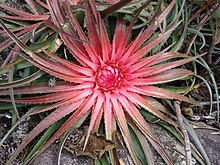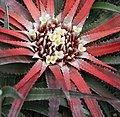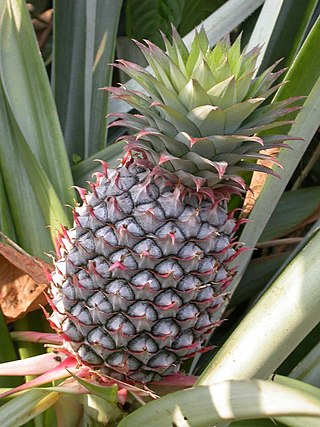
The Bromeliaceae are a family of monocot flowering plants of about 80 genera and 3700 known species, native mainly to the tropical Americas, with several species found in the American subtropics and one in tropical west Africa, Pitcairnia feliciana.
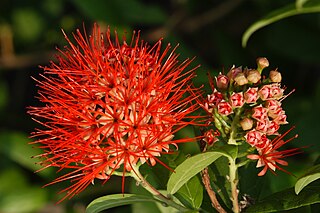
The Combretaceae, often called the white mangrove family, are a family of flowering plants in the order Myrtales. The family includes about 530 species of trees, shrubs, and lianas in ca 10 genera. The family includes the leadwood tree, Combretum imberbe. Three genera, Conocarpus, Laguncularia, and Lumnitzera, grow in mangrove habitats (mangals). The Combretaceae are widespread in the subtropics and tropics. Some members of this family produce useful construction timber, such as idigbo from Terminalia ivorensis. The commonly cultivated Quisqualis indica is now placed in the genus Combretum. Many plants in the former Quisqualis genus contain the excitotoxin quisqualic acid, a potent AMPA agonist.

Manihot is a genus in the diverse milkspurge family, Euphorbiaceae. It was described as a genus in 1754.
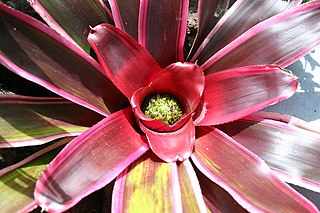
Neoregelia is a genus of epiphytic flowering plants in the family Bromeliaceae, subfamily Bromelioideae, native to South American rainforests. The genus name is for Eduard August von Regel, Director of St. Petersburg Botanic Gardens in Russia (1875–1892).

The Capparaceae, commonly known as the caper family, are a family of plants in the order Brassicales. As currently circumscribed, the family contains 15 genera and about 430 species. The largest genera are Capparis, Morisonia, Maerua, Boscia, and Cadaba.

Bromelioideae is a subfamily of the bromeliads (Bromeliaceae). This subfamily is the most diverse in the family, represented by the greatest number of genera with about 40. Most of the plants in this group are epiphytes, though some have evolved in, or will adapt to, terrestrial conditions. This subfamily features the most plant types which are commonly cultivated by people, including the pineapple.
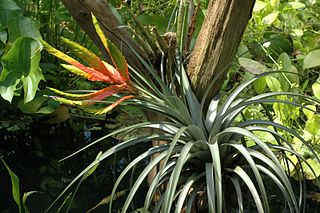
Tillandsioideae is a subfamily of plants in the bromeliad family Bromeliaceae. This subfamily contains the greatest number of species. Most are epiphytic or lithophytic, growing in trees or on rocks where they absorb water and nutrients from the air. Spanish moss of the genus Tillandsia is a well-known species. Bromeliads in the genera Guzmania and Vriesea are the more commonly cultivated members of this subfamily.

Orthophytum is a genus in the plant family Bromeliaceae, subfamily Bromelioideae.
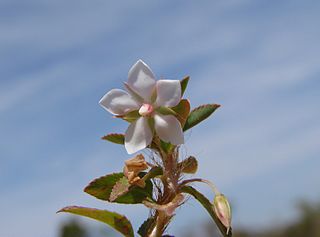
Sauvagesia is a genus of plants in the family Ochnaceae. It includes 49 species native to the tropical Americas, tropical Africa, and Madagascar.
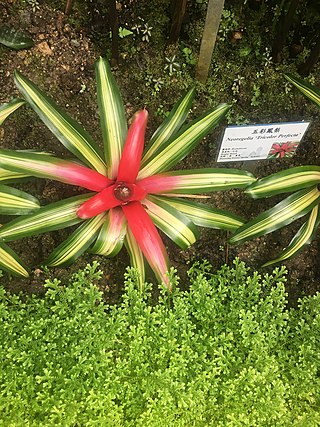
Hylaeaicum eleutheropetalum is a species of flowering plant in the family Bromeliaceae, native to tropical South America. It was first described in 1907.

Sincoraea heleniceae is a species of flowering plant in the family Bromeliaceae, native to Brazil. It was first described in 2004 as Orthophytum heleniceae.
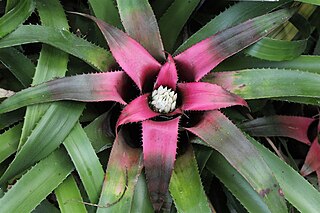
Hylaeaicum is a genus of flowering plant in the family Bromeliaceae, native to tropical northern South America. The taxon was first described by Ernst Heinrich Georg Ule in 1935 as a subgenus of "Aregelia". It was later treated as a subgenus of Neoregelia, before being raised to a full genus in 2021, a status accepted by both Plants of the World Online and the Encyclopaedia of Bromeliads.
Hylaeaicum myrmecophilum is a species of flowering plant in the family Bromeliaceae, native to northern Brazil, Colombia, Ecuador and Venezuela. It was first described by Ernst Heinrich Georg Ule in 1905.
Sincoraea navioides is a species of flowering plant in the family Bromeliaceae, native to Brazil. It was first described by Lyman Bradford Smith in 1940 as Cryptanthopsis navioides.
Ernst Heinrich Georg Ule was a German botanist and plant collector.
Cipuropsis is a genus of flowering plant in the family Bromeliaceae, native to the Caribbean, southern Central America and northwestern South America. The genus was first described by Ule in 1907.

Amphilophium is a genus of flowering plants in the family Bignoniaceae, native to South America. Amphilophium crucigerum has escaped from cultivation elsewhere, and has become an invasive weed in Australia.
Marcetia is a genus of flowering plants belonging to the family Melastomataceae.
Cereus trigonodendron, synonym Cereus braunii, is a species of flowering plant in the family Cactaceae, native to Bolivia, North Brazil and Peru. It was first described in 1908 by Ernst Heinrich Georg Ule who attributed the name to Karl Moritz Schumann. Ule described Cereus trigonodendron as a striking triangular columnar cactus, up to 15 m tall, with large purple flowers at the top.
Josemania is a genus of flowering plant in the family Bromeliaceae, first described in 2016.
